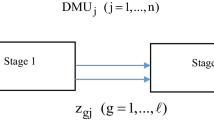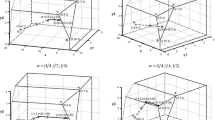Abstract
In this paper Data Envelopment Analysis (DEA) is used to assess the relative efficiency of a set of decision-making units (DMUs). Each DMU is evaluated on the basis of the ratio of its weighted output (i.e. virtual output) over its weighted input (i.e. virtual input). Conventional DEA models allow each DMU to select the weighting scheme which optimizes its own evaluation. However, this total flexibility has drawbacks and in certain contexts may not be desirable. In such cases, it may be more appropriate to consider a common set of weights to benchmark and rank the alternatives using a common platform. In this paper, bargaining theory is used to determine a common set of weights in DEA. The advantage of using a bargaining approach is that the weights emerge bottom-up as the result of an agreement between the DMUs, instead of using an exogenous criterion imposed from above. The novelty of the proposed approach is that we consider two players per DMU, one whose utility function corresponds to its virtual input, and another whose utility is the negative of the virtual input. Thus, each DMU wants to choose the output weights so as to maximize its virtual output, and the input weights so as to minimize its virtual input. In this way, all DMU try to appear under the best possible light but the input and output weights are common and agreed. Models based on the Nash and the Kalai–Smorodinsky solutions are formulated and an application to a supplier selection problem is presented.





Similar content being viewed by others
Notes
\(\mathbb {R}\) (\(\mathbb {R}_+\), \(\mathbb {R}_{++}\)) denotes the set of all (non-negative, positive) real numbers. \(\mathbb {R}^n\)(\(\mathbb {R}^n_+\), \(\mathbb {R}^n_{++}\)) is the Cartesian product of n copies of \(\mathbb {R}\) (\(\mathbb {R}_+\), \(\mathbb {R}_{++}\)).
For vector inequalities, \(s\geqq s'\) means that \(s_i\ge s'_i\) for all \(i=1,\ldots , n\); \(s\ge s'\) means that \(s\geqq s'\) and \(s\ne s'\); \(s>s'\) means that \(s_i> s'_i\) for all \(i=1,\ldots , k\).
References
Amin GR, Toloo M (2007) Finding the most efficient DMUs in DEA: an improved integrated model. Comput Ind Eng 52:71–77
Anderson TR, Hollingsworth K, Inman L (2002) The fixed weighting nature of a cross-evaluation model. J Product Anal 17:249–255
Angiz MZ, Mustafa A, Kamali MJ (2013) Cross-ranking of decision making units in data envelopment analysis. Appl Math Model 37:398–405
Banker RD, Charnes A, Cooper WW (1984) Some models for estimating technical and scale inefficiencies in data envelopment analysis. Manag Sci 30(9):1078–1092
Barzegarinegad A, Jahanshahloo G, Rostamy-Malkhalifeh M (2014) A full ranking for decision making units using ideal and anti-ideal points in DEA. Sci World J 2014:1–9
Belton V, Vickers SP (1993) Demystifying DEA: a visual interactive approach based on multiple criteria analysis. J Op Res Soc 44(9):883–896
Carrillo M, Jorge JM (2016) A multiobjective DEA approach to ranking alternatives. Exp Syst Appl 50:130–139
Charnes A, Cooper WW, Rhodes E (1978) Measuring the efficiency of decision making units. Eur J Op Res 2(6):429–444
Chiang CI, Tzeng GH (2011) A multiple objective programming approach to Data Envelopment Analysis. In: Shi Y, Zeleny M (eds) New frontiers of decision making for the information technology era (2000). World Scientific, Singapore, pp 270–285
Contreras I (2011) A DEA-inspired procedure for the aggregation of preferences. Exp Syst Appl 38:564–570
Cook WD, Kress M (1990) A data envelopment model for aggregating preference rankings. Manag Sci 36(11):1302–1310
Cook WD, Kress M (1991) A multiple criteria decision model with ordinal preference data. Eur J Op Res 54(2):191–198
Despotis DK (2002) Improving the discriminating power of DEA: focus on globally efficient units. J Op Res Soc 53(3):314–323
Driessen B (2012) Proportional concessions and the leximin solution. Econo Lett 114(2012):288–291
Ferreira D, Marques R (2017) A step forward on order-\(\alpha\) robust nonparametric method. Inclusion of weight restrictions, convexity and non-variable returns of scale. Op Res. https://doi.org/10.1007/s12351-017-0370-1
Ferreira D, Marques R (2018) Do quality and access to hospital services impact on their technical efficiency? Omega Int J Manag Sci. https://doi.org/10.1016/j.omega.2018.07.010
Ferreira D, Nunes A, Marques R (2018) Doctors, nurses and the optimal scale size in the Portuguese public hospitals. Health Policy. https://doi.org/10.1016/j.healthpol.2018.06.009
Friedman L, Sinuany-Stern Z (1997) Scaling units via the canonical correlation analysis in the DEA context. Eur J Op Res 100:629–637
Gutiérrez E, Lozano S (2018) Benchmarking formula one auto racing circuits: a two stage DEA approach. Oper Res Int J. https://doi.org/10.1007/s12351-018-0416-z
Hashimoto A, Wu DA (2004) A DEA—compromise programming model for comprehensive ranking. J Op Res 47(2):73–81
Hatami-Marbini A, Tavana M, Agrell PJ, Lotfi FH, Beigi ZG (2015) A common-weights DEA model for centralized resource reduction and target setting. Comput Ind Eng 79:195–203
Hinojosa MA, Lozano S, Marmol AM (2016) Nash decomposition for process efficiency in multistage production systems. Exp Syst Appl 55(2016):480–492
Imai H (1983) Individual monotonicity and lexicographic maxmin solution. Econo J Econo Soc 51(2):389–401
Jahanshahloo GR, Zohrehbandian M, Alinezhad A, Abbasian Naghneh S, Abbasian H, Kiani Mavi R (2011) Finding common weights based on the DM’s preference information. J Op Res Soc 62:1796–1800
Jahanshahloo G, Hadeghi J, Khodabakhshi M (2017) Proposing a method for fixed cost allocation using DEA based on the efficiency invariance and common set of weights principles. Math Methods Op Res 85:223–240
Kalai E (1977) Proportional solutions to bargaining situations: interpersonal utility comparisons. Econometrica 45(7):1623–1630
Kalai E, Smorodinsky M (1975) Other solutions to Nash’s bargaining problem. Econometrica 43(3):513–518
Kao C, Hung HT (2005) Data envelopment analysis with common weights: the compromise solution approach. J Op Res Soc 56:1196–1203
Karsak EE, Ahiska SS (2008) Improved common weight MCDM model for technology selection. Int J Prod Res 46(24):6933–6944
Lam KF (2016) Finding a common set of weights for ranking decision-making units in data envelopment analysis. J Econo Bus Manag 4(9):534–537
Li XB, Reeves GR (1999) A multiple criteria approach to data envelopment analysis. Eur J Op Res 115:507–517
Li F, Song J, Dolgui A, Liang L (2017) Using common weights and efficiency invariance principles for resource allocation and target setting. Int J Prod Res 55(17):4982–4997
Liu FHF, Peng HH (2009) A systematic procedure to obtain a preferable and robust ranking of units. Comput Op Res 36:1012–1025
Lotfi FH, Jahanshahloo GR, Memariani A (2000) A method for finding common set of weights by multiple objective programming in data envelopment analysis. Southwest J Pure Appl Math 1:44–54
Lotfi FH, Hatami Marbini A, Agrell PJ, Aghayi N, Gholami K (2013) Allocating fixed resources and setting targets using a common-weights DEA approach. Comput Ind Eng 64:631–640
Lozano S (2016) Slacks-based inefficiency approach for general networks with bad outputs: an application to the banking sector. Omega 60:73–84
Lozano S, Gutierrez E (2014) A slacks-based network DEA efficiency analysis of European airlines. Trans Plan Technol 37(7):623–637
Lozano S, Hinojosa MA, Mármol AM (2018) Extending the bargaining approach to DEA target setting. Omega. https://doi.org/10.1016/j.omega.2018.05.015
Lozano S, Hinojosa MÁ, Mármol AM, Borrero DV (2016) DEA and cooperative game theory. In: Hwang SN, Lee HS, Zhu J (eds) Handbook of operations analytics using data envelopment analysis. Springer, New York, pp 215–239
Makui A, Alinezhad A, Mavi RK, Zohrehbandian M (2008) A goal programming method for finding common weights in DEA with an improved discriminating power for efficiency. J Ind Syst Eng 1(4):293–303
Nakabayashi K, Tone K (2006) Egoist’s dilemma: a DEA game. Omega 34:135–148
Nash JF (1950) The bargaining problem. Econometrica 28:155–162
Omrani H (2013) Common weights data envelopment analysis with uncertain data: a robust optimization approach. Comput Ind Eng 66:1163–1170
Payan A (2015) Common set of weights approach in fuzzy DEA with an application. J Intell Fuzzy Syst 29:187–194
Puri J, Yadav SP, Garg H (2017) A new multi-component DEA approach using common set of weights methodology and imprecise data: an application to public sector banks in India with undesirable and shared resources. Ann Op Res 259:351–388
Qi XG, Guo B (2014) Determining common weights in data envelopment analysis with Shannon’s entropy. Entropy 16:6394–6414
Ramón N, Ruiz JL, Sirvent I (2012) Common sets of weights as summaries of DEA profiles of weights: with an application to the ranking of professional tennis players. Exp Syst Appl 39:4882–4889
Rezaie V, Ahmad T, Awang SR, Khanmohammadi M, Maan N (2014) Ranking DMUs by calculating the interval efficiency with a common set of weights in DEA. J Appl Math 2014:1–9
Retzlaff-Roberts DL (1996) Relating discriminant analysis and data envelopment analysis to one another. Comput Op Res 23(4):311–322
Roll Y, Cook WD, Golany B (1991) Controlling factor weights in data envelopment analysis. IIE Trans 23:2–9
Roll Y, Golany B (1993) Alternate methods for treating factor weights in DEA. Omega 21(1):99–109
Roth AE (1979) Proportional solutions to the bargaining problem. Econometrica 47:775–778
Rousseau JJ, Semple JH (1995) Two-person ratio efficiency games. Manag Sci 41(3):435–441
Semple J (1996) Constrained games for evaluating organizational performance. Eur J Op Res 96:103–112
Sinuany-Stern Z, Friedman L (1998) DEA and the discriminat analysis of ratios for ranking units. Eur J Op Res 111:470–478
Sueyoshi T (2001) Extended DEA-discriminant analysis. Eur J Op Res 131:324–351
Sugiyama M, Sueyoshi T (2014) Finding a common weight vector of data envelopment analysis based upon bargaining game. Stud Eng Technol 1(1):13–21
Sun J, Wu J, Guo D (2013) Performance ranking of units considering ideal and anti-ideal DMU with common weights. Appl Math Model 37:6301–6310
Talluri S, Baker RC (2002) A multi-phase mathematical programming approach for effective supply chain design. Eur J Op Res 141:544–558
Thanassoulis E, Dyson RG (1992) Estimating preferred target input–output levels using data envelopment analysis. Eur J Op Res 56:80–97
Thomson W (2010) Bargaining and the theory of cooperative games: John Nash and beyond. Edward Elgar Publishing, Norhampton
Toloo M, Tavana M, Santos-Arteaga FJ (2017) An integrated data envelopment analysis and mixed integer non-linear programming model for linearizing the common set of weights. Central European Journal of Operations Research, In press
Troutt MD (1997) Derivation of the maximin efficiency ratio model from the maximum decisional efficiency principle. Ann Op Res 73:323–338
Von Neumann J, Morgenstern O (1953) Theory of games and economic behavior, 3rd edn. Princeton University Press, Princeton
Wang M, Li Y (2014) Supplier evaluation based on Nash bargaining game model. Exp Syst Appl 41:4181–4185
Wang M, Luo Y, Liang L (2009) Ranking decision making units by imposing a minimum weight restriction in the data envelopment analysis. J Comput Appl Math 223:469–484
Wang YM, Luo Y, Lan YX (2011) Common weights for fully ranking decision making units by regression analysis. Exp Syst Appl 38:9122–9128
Wu J, Liang L, Yang F, Yan H (2009) Bargaining game model in the evaluation of decision making units. Exp Syst Appl 36:4357–4362
Wu J, Chu J, Zhu Q, Li Y, Liang L (2016) Determining common weights in data envelopment analysis based on the satisfaction degree. J Op Res Soc 67:1446–1458
Acknowledgements
The research of the authors has been supported by the Spanish Ministry of Science, Innovation and Universities under Project PGC2018-095786-B-I00.
Author information
Authors and Affiliations
Corresponding author
Additional information
Publisher's Note
Springer Nature remains neutral with regard to jurisdictional claims in published maps and institutional affiliations.
Rights and permissions
About this article
Cite this article
Contreras, I., Lozano, S. & Hinojosa, M.A. A bargaining approach to determine common weights in DEA. Oper Res Int J 21, 2181–2201 (2021). https://doi.org/10.1007/s12351-019-00498-w
Received:
Revised:
Accepted:
Published:
Issue Date:
DOI: https://doi.org/10.1007/s12351-019-00498-w




